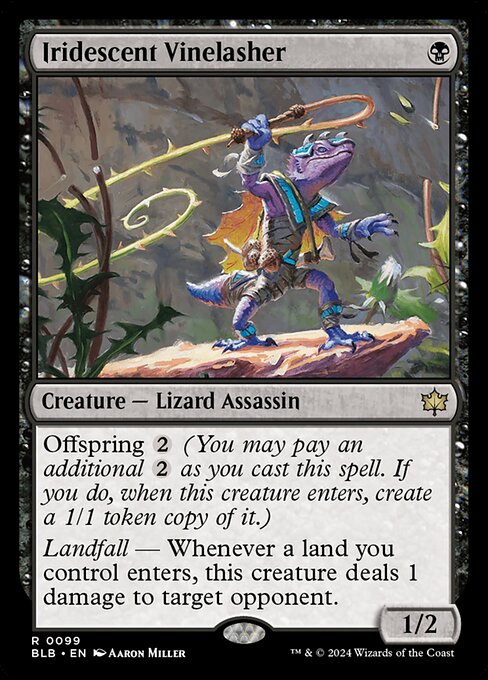
Image courtesy of Scryfall.com
Green's Ramp, Resilience, and the Color Pie—Through Black's Lens
Iridescent Vinelasher arrives at the table with a name that sparkles with color-tinted curiosity. A single black mana cost for a 1/2 creature might feel modest at first glance, but the card design digs deep into the color pie’s philosophy by pairing two ideas you don’t always see in Black: ramp-like acceleration and a taste for resilient, mass-friendly growth. In the Bloomburrow set, Iridescent Vinelasher leans into the Offspring mechanic and the Landfall trigger to sketch a strategy that reads as both classic Black and surprisingly green-adjacent. The result is a creature that, with a little mana-mathemagic, can snowball into real board presence 🧙♂️🔥. The core of Vinelasher’s identity is codified in its two standout abilities: Offspring and Landfall. Offspring lets you pay an extra {2} as you cast this spell; if you choose to do so, when the creature enters, you create a 1/1 token copy of it. That token is not just extra power on the board—it’s an echo of your investment, a micro-swarm that can swarm the battlefield over successive turns. It’s a design mirror of green’s appetite for proliferating threats and board presence, channeled through black’s appetite for value generation even at the moment of entry. The token copy improves the unit’s long-game staying power and pressures your opponent’s life total in a way that feels green at heart, even though the card wears Black’s hoodie with quiet pride. 💎 Then there’s Landfall, a mechanic most players associate with green’s lands-forward tempo. Whenever a land you control enters the battlefield, Vinelasher pings an opponent for 1 damage. It’s a simple, elegant nudge that scales with your mana-base and your land drops, reinforcing a rampy, tempo-savvy lane. In practical terms, this means a deck that leans into land plays—fetchables, mana-floozled supports, and fetch-land combos—can accumulate incremental damage across turns as new lands roll in. The synergy between producing bodies via Offspring and dealing incremental damage via Landfall gives Black a surprising lane to ride: resilience through recursion, threat multiplication through token generation, and a light, green-like push in the late game that tests your opponent’s removal calculus. ⚔️ From a gameplay perspective, Iridescent Vinelasher rewards a thoughtful casting cost management strategy. If you pay the extra {2}, you buy yourself a tiny accelerant: a token copy that not only swells your board but also makes future landfalls more punishing as the total power on the battlefield grows. It epitomizes black’s flair for value-backed threats—pay a little now to reap a larger result later—and it flips the script on the classic “one-and-done” loop by introducing a cadence of churn and replication. In multiplayer formats like Commander, that Offspring option becomes a mini-ecosystem: you can push for exponential pressure if the table has a steady stream of additional land drops, or hold the line with your copying engine while the board stabilizes. It’s Black playing a little green-influenced agriculture, with a dash of red-hot aggression on the harvest 🎲. For lore and flavor, Iridescent Vinelasher’s title evokes iridescence and cunning—a perfect metaphor for a card that shifts color identity depending on how you invest in it. The “offspring” motif speaks to cycles, lineage, and the idea that life comes in copies and echoes, a vibe you often see threaded through Black’s fascination with lifecycles, souls, and the darker aspects of metamorphosis. Yet the Landfall trigger stands as a reminder that land-based momentum remains a universal engine in Magic: the Gathering’s world-building fabric, a concept that Green often owns, but which Black borrows for a moment of pragmatic ramp and pressure. The result is a card that feels like a cross-pollination between two colors, a bridge that helps players appreciate the color pie not as a prison but as a set of design levers you can pull to surprise the board. 🧙♂️🎨 If you’re eyeing Iridescent Vinelasher for a deck, think of it as a compact ramp engine that can pivot toward a token swarm or a targeted damage plan, depending on your local meta. In a dedicated ramp shell, you can lean into the green-school idea of “more lands, more threats” by pairing Vinelasher with ways to accelerate land drops and protect your board state—cards that untap, untap, or untap again can make those Landfall triggers feel like a steady drumbeat. In a more midrange or aristocrat-adjacent Black shell, the ability to copy itself on entry means you’re leaning into value: the original Vinelasher plus its 1/1 token can become a persistent nuisance, especially when you wring extra value from sacrifice or ETB-drawing engines. The card’s flexibility is its superpower, and its rare status in Bloomburrow makes it a sweet highlight for collectors and casual players alike who crave a unique piece for their Black-centered builds. ⚡💎 As a promotional note, if you’re browsing MTG-inspired gear in the same ecosystem that celebrates card design as design narrative, you might also enjoy the practical, everyday carry elegance of a sleek phone case with card holder—a nod to how modern enthusiasts like to blend function with fandom. The featured product—Phone Case with Card Holder MagSafe Polycarbonate Matte/Gloss—couples with the same spirit of hybrid utility that Iridescent Vinelasher embodies on the battlefield. If you’re picking up a case for your device, think of it as armor for your deck-building adventures: durable, stylish, and ready to carry your rare finds into the next game night 🧙♂️🔥. Phone Case with Card Holder MagSafe – Polycarbonate Matte/GlossMore from our network
- https://transparent-paper.shop/blog/post/designing-modern-infographic-templates-for-visual-impact/
- https://crypto-acolytes.xyz/blog/post/demystifying-liquidity-pools-how-defi-operates/
- https://crypto-acolytes.xyz/blog/post/how-whales-manipulate-intraday-prices-truths-and-impacts/
- https://blog.digital-vault.xyz/blog/post/mastering-layered-transparent-overlays-on-digital-paper/
- https://blog.digital-vault.xyz/blog/post/un-set-visuals-unraveled-dwarven-hold-design-constraints/